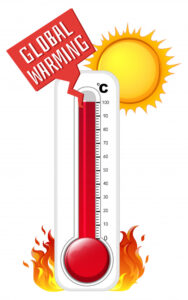 With the mercury rising into the 90s most of last week, it felt like August already, the air heavy and humid. The bad news, of course, is it’s not only not August, it’s not even summer. The solstice is still a few days off…
With the mercury rising into the 90s most of last week, it felt like August already, the air heavy and humid. The bad news, of course, is it’s not only not August, it’s not even summer. The solstice is still a few days off…
Welcome to life in the New Abnormal, the climate changing before our very eyes.
It’s not only getting hotter, it’s getting wetter. The skies opened up last Tuesday evening, flooding the region– again– with a dumping, a good downpour here in Roxborough, but a startling 7 inches of rain near Coatesville. For perspective, that was two months’ of rain in just one evening in parts of Chester County.
The number of large downpours in our region has spiked even higher than temperatures. In the 1950s, the largest amount of rainfall on the worst day used to be 2, maybe 2.5 inches in one day. Nowadays, the amount of rainfall on the largest rainfall day has jumped a full 50%, and we get about 3.75 inches of rain on the wettest day, a significant increase.
Worse, the number of large downpours in Pennsylvania has grown by 360% since 1950. Translated, we now receive almost five times as many heavy downpours today as we did back then. And if you line up the 50 American cities with the largest increases, we rank number 3 in the entire country. We finally beat New York, which came in at #4 with “only” a 350% increase. (Numbers 1 and 2? McAllen, Texas and, oddly, Portland, Maine.)
But back to heat. Climate Central, a science-based organization out of Princeton that offers factual data on our climate, noted in 2018 that Philadelphia was experiencing 16.8 days of hotter-than-normal temperatures. If climate was not changing, we would expect warmer days and cooler days to essentially seesaw around the norm– cooler days this week balanced by warmer ones the next.
In 1970, about 40 summertime days were hotter than normal. Today, 57 days– almost a full two months– of summer are higher than average temperature-wise.
Also in 1970, the first Philadelphia day that measured 85 degrees arrived in mid-May; today, it comes in late April, on average almost two weeks earlier than it once did.
In that same vein, in 1970 we only suffered from four days of heat above 95 degrees. Today, we have added five more days of these sweltering temperatures, up to nine of them annually. (This year, it feels like we have hit that number already).
We currently should not have any days above 100 degrees in Philadelphia– they were rare and unexpected, But by 2050, says Climate Matters, depending on what happens in the years ahead, we may hit that mark 10-11 times annually. Ugh.
But Philadelphia is part of the larger world, where a number of unsettling trends are occurring. While the hurricane season doesn’t officially start until June 1, this year’s first named storm– Ana– arrived in late May, the SEVENTH consecutive year a named storm formed before the June 1 opening, a rarity that has now become a trend. That June date was not picked randomly: that was when the ocean’s surface temperatures were finally warm enough to generate the energy needed for a hurricane. Today, the ocean surface is warm enough in May.
California, the Pacific Northwest, the Northern Plains, and much of the Southwest is in the grips of a fierce drought. For California, this is business as usual, sadly, as this has happened in 13 of the last 22 years. The breadbasket of so much of the country and world, California is drying out, Last year’s record wildfires burned four million acres, and this year’s dry conditions have started a month earlier than expected. A
Lake Mead, the massive reservoir behind the Hoover Dam, is at record lows. “It has fallen 140 feet since 2000,” reported Reuters last week, “nearly the height of the Statue of Liberty from torch to base, exposing a bathtub ring of bleached-white embankments.”
Farmers are giving up and abandoning their fields, Nevada is restricting lawn watering over much of Las Vegas, and the governor of Utah literally asked his state’s residents to pray for rain. Not sure “thoughts and prayers” will cure our climate ills.
A 2020 study published in the journal Science soberly reported that 2000 through 2018 was the second-driest 19-year period in the Southwest in at least the past 1,200 years.
Finally, the amount of carbon dioxide in the Earth’s atmosphere reached 419 parts per million in May, its highest level in more than four million years, the National Oceanic and Atmospheric Administration announced last week. After dipping last year because of pandemic-fueled lockdowns, greenhouse gas emissions have begun to rise again as economies open and people resume work and travel. “The newly released data about May carbon dioxide levels show that the global community so far has failed to slow the accumulation of heat-trapping gases in the atmosphere,” NOAA said in its announcement.
For context, the last time CO2 levels exceeded 400 parts per million was during the Pliocene era, when global temperatures were more than five degrees warmer and sea levels were between 30 and 80 higher than they are now.
But back to Philadelphia. Early June heat waves should not be a thing, and storms dumping 7 inches of rain should not either. This is not normal. Or expected. Or average.
It is, however, the New Abnormal, which, if we ignore it, will only worsen. Chew on this as we tiptoe warily into, hopefully, a pandemic-free summer.
Mike Weilbacher directs the Schuylkill Center for Environmental Education in Upper Roxborough, tweets @SCEEMike, and can be reached at [email protected].
